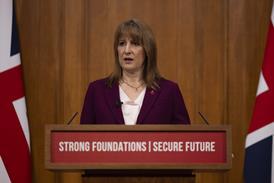The chancellor’s Budget speech has not had the disastrous immediate impact on markets that many had feared – despite gilts falling in response to new government data published after the speech.
The FTSE 100 is up at the end of 27 November, after dipping to 9,593 points at the start of the chancellor’s speech. Since the start of the day on Wednesday, the market is up by just over 0.8%.

“Despite an immediate FTSE dip, market reaction to the leaked Office of Budget Responsibility document was pretty subdued,” said Matt Tickle, chief investment officer at Barnett Waddingham. “Some front-loading of welfare spending and longer-term tax rises might generate headlines for a few weeks, but none of the fiscal changes look substantial enough to impact the gilt or sterling markets.”
However, the CIO warned against expecting this week’s announcements to bolster markets.
“The markets are crying out for policies that truly support economic growth – deregulation, investment in R&D, and pro-worker, pro-business taxation,” said Tickle. “This budget didn’t do that.”
Gilt yields tick lower
Gilts had a similar response to the Budget as the FTSE 100, but the large reaction has come in the hours since.
The 10-year gilt yield after the chancellor’s speech, following news from the Debt Management Office (DMO) that this year’s increase in issuance would be lower than expected. The DMO revised up its plan for gilt issuance in the financial year to £303.7bn, but this fell short of the widely expected £307.7bn of issuance.
Towards the end of Thursday, the 10-year yield was 4.46%.
Despite subsequent falls in gilts – by circa 0.4% in 10-year yields - this has not sparked a panic among commentators.
Peder Beck-Friis, economist at PIMCO, said Rachel Reeves had done enough in the Budget to trigger a “relief rally” in gilts.
“The additional risk premium that was priced in after the income tax U-turn has now been largely priced out, and over the next few months, markets can now re-focus on inflation, the labour market and the likelihood of renewed rate cuts from the Bank of England,” Beck-Fris said.
“Our view remains that a weakening labour market and softening inflation will result in a deeper rate-cutting cycle than markets are pricing, and by helping to reduce inflationary pressures into next year, the Budget has further reinforced those dynamics.”
“Our interpretation of the market’s initial reaction: the Budget has cleared the lower bar set by markets in the run-up to its official release.”
Chris Arcari, Hymans Robertson
Chris Arcari, head of capital markets at Hymans Robertson, added: “While debt-crisis concerns seem a little far-fetched, UK yields are vulnerable to sentiment, and the market needs to believe that fiscal-consolidation plans for balancing revenue and day-to-day spending are credible. But with the major revenue-raising levers off the table, it makes it harder for the chancellor to deliver.
“So far, yields have fallen, with larger falls at shorter terms, and sterling has trended up modestly versus the dollar. Our interpretation of the market’s initial reaction: the Budget has cleared the lower bar set by markets in the run-up to its official release.”
By mid-afternoon, the sterling was up against the dollar and the euro by around 0.53% and 0.29%, respectively.
Mark Preskett, senior portfolio manager at Morningstar Wealth, was similarly sanguine: “With inflation showing recent signs of moderation, we would expect gilt yields to continue their downward trajectory once the dust settles from the budget.
“Overall, sterling has strengthened against both the dollar and the euro – a reflection that the Budget has been reasonably well received by investors.”






















